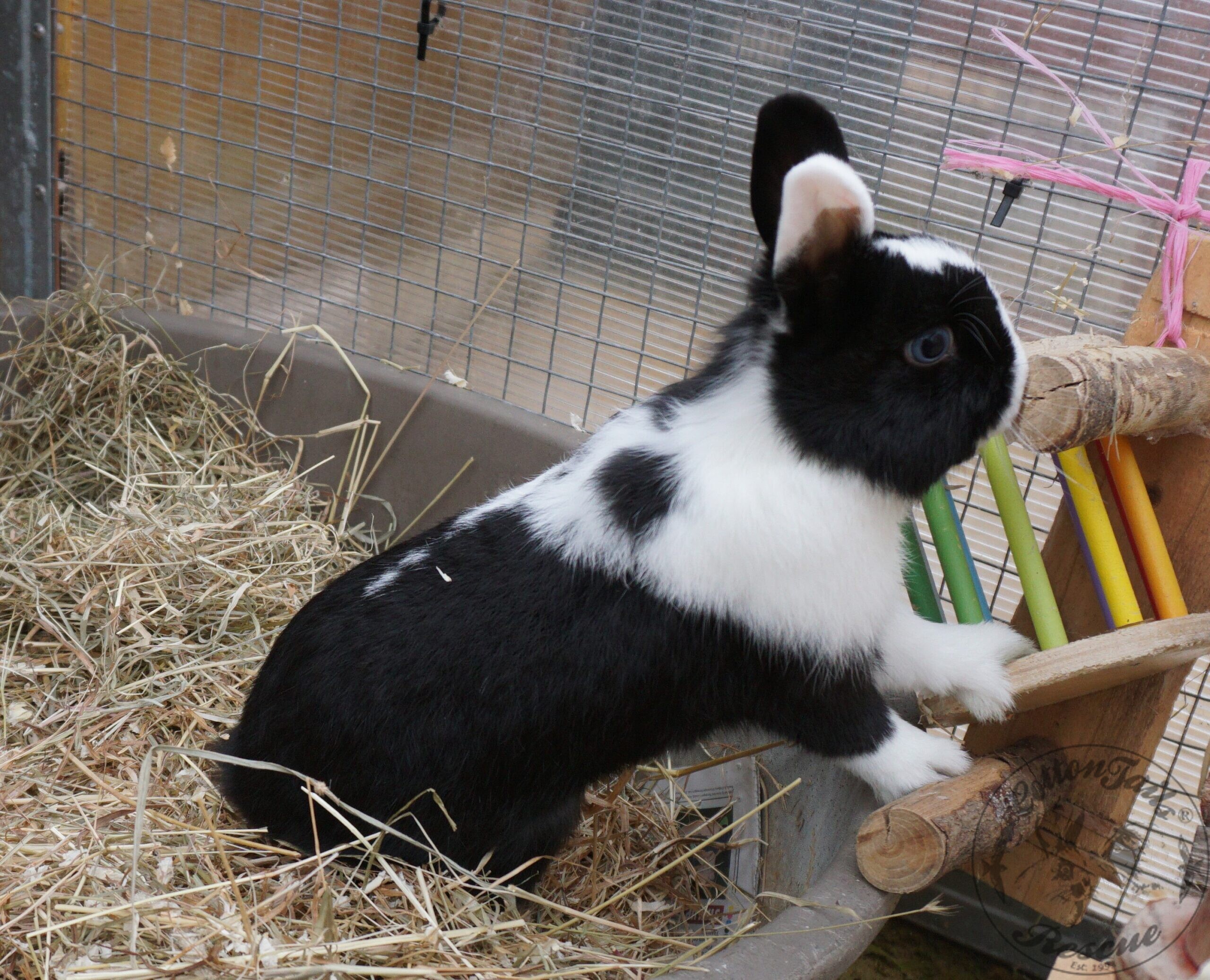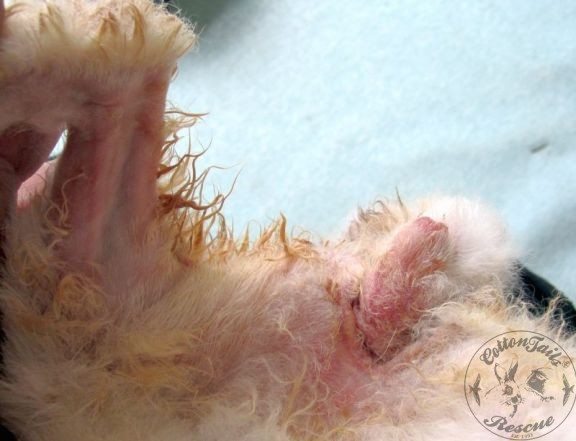There are many causes for a rabbit becoming wet around its tail. The symptoms are often noticed when the rabbit’s urine flows down one or both hind legs instead of being expelled backwards cleanly past the tail. This causes it to be either very damp or soaking wet, depending on the severity of the condition. It often starts slowly, with the owner noticing that the rabbit seems to be wet around the tail area. Over time (sometimes days, sometimes weeks), it progressively worsens to the point where it is very painful and distressing to the rabbit.
The photo below shows Marmite when he first came into the centre. His skin was very sore, red and wet, and every time he needed to pass urine, he would give a pitiful little crying noise due to the pain of the urine hitting his raw skin. Thankfully, after much work, Marmite was completely cured, successfully matched with a neutered female, and adopted as part of a bonded pair.
The scalding itself results from the fur and skin being frequently wet, with the fur falling out due to bacterial and fungal infection of the surrounding skin, making the area red and sore. The condition is a very serious one, and treatment must be started straight away; otherwise, not only will the rabbit be in distress, but it will also have a high risk of fly strike. I have included some of the common causes below.
Obesity – if a rabbit is overweight, it can develop bulges and folds of skin in various parts of the body, including the lower abdomen, resulting in the urine becoming trapped and running down a leg. For information about the correct diet to cure this problem, have a look at the feeding part of the rabbit care section.
Arthritis – this is fairly common in older rabbits and can result in the inability to raise the back end properly, which means the rabbit is unable to urinate clear of the hind legs. Ask your vet for pain relief/anti-inflammatory treatment for the rabbit, as a low dose of Metacam once daily can alleviate the pain and discomfort, which enables the rabbit to adopt the correct posture for urination once again. In some cases, gentle massage of the hind legs with or without gentle heat can positively affect the mobility of a rabbit with arthritis, resulting in the proper position for correct urination, clear of legs and tail.
E. cuniculi – this topic is covered more extensively in the rabbit care section of the website. Many rabbits infected with the parasite E. cuniculi develop hind leg weakness, which affects their movement and results in an inability to adopt the correct posture for urination, resulting in urine scalding of the hind legs. The parasite can also affect the nerve control of the bladder, which means that the urine trickles out almost constantly, and the rabbit has no control over it. Although treatment with Panacur is now routine for E. cuniculi, it is not guaranteed that this will undo all the damage already done. The rabbit will often not recover if it is too severely affected.
Injury – this can affect urination in two ways: one as a result of pain in the hind quarters resulting in an inability to adopt the correct position for urination; the other is due to mechanical damage resulting in the genital area becoming off-centre in relation to the abdomen and the flow of urine being directed sideways onto a hind leg. Pain can be managed with a degree of success, as outlined above (arthritis). Sadly, mechanical damage is rarely treatable, and more often than not, the rabbit would need to be put to sleep unless the vet feels confident that an operation to correct the position would be possible and feasible.
Post-castration complication – It is not common, but in a very small minority of neutered males, the exit of the urethra (where the urine comes out of the body) becomes very constricted and tight. This results in the rabbit trying to empty its bladder through a pin-prick hole instead of the relatively wide tube-like structure that should be present in males neutered for more than six months. The penis regresses to a tube in most neutered males as adult development depends on testosterone. When that decreases with castration, the sexual development reverts again to the immature form. This constriction of the exit often results in urine dribbling out instead of being expelled with force, which causes the urine to trickle onto the legs and tail as the rabbit cannot empty its bladder correctly. In addition, the genital area often becomes swollen, sore, red and infected, worsening the problem. Gentle stretching of the opening by a vet can cure the problem, so long as the direction of the urine flow is straight once the procedure has been carried out; otherwise, the rabbit will continue to wet one or both legs. Treatment with antibiotics is usually required to alleviate any infection, and sometimes, anti-fungal topical cream needs to be applied if a fungal infection is suspected.
Infection – it is worth trying a course of antibiotics just in case the problem is caused by a bladder or urinary tract infection. If the skin looks red and sore, an anti-fungal cream applied thinly and gently to the area may be worth trying. This can be bought from a chemist’s shop, but if you think the rabbit may be in danger of licking it off, you may be best to use something like Daktarin oral gel. Only use this for a few days, as that should be enough to be sure that a fungal infection is treated, and if the symptoms persist, you must seek veterinary advice.
Crystals or sludge in the bladder or urethra can cause enough of a blockage to cause urine scalding. The bladder cannot empty properly, and the urine dribbles out slowly, all over the tail and legs.
Have no illusions about this issue, urine scalding is a serious issue. Treatment must be sought immediately, or the appropriate action must be taken if the vet does not think treatment will be successful. Doing nothing is not an option, nor is simply repeatedly washing the rabbit, which will worsen the situation. The only justification for washing is if the urine leakage is very infrequent, but even then, you must find out the cause of the problem and take steps to resolve it rather than try to treat the symptoms.


